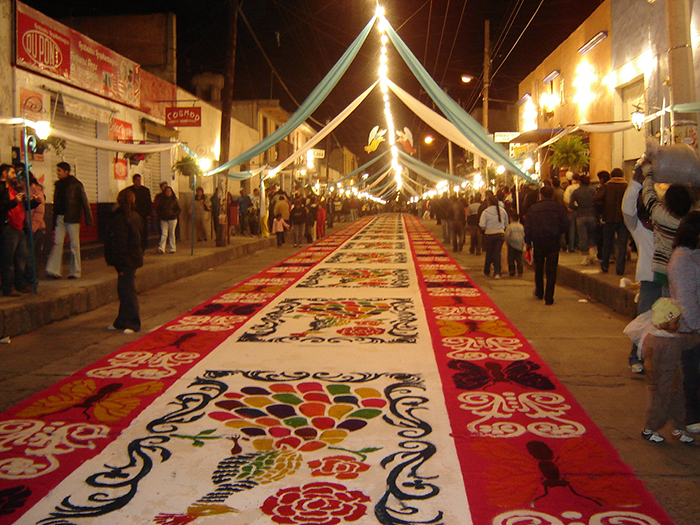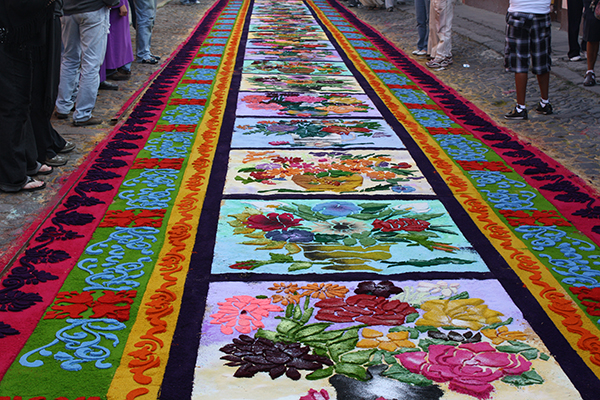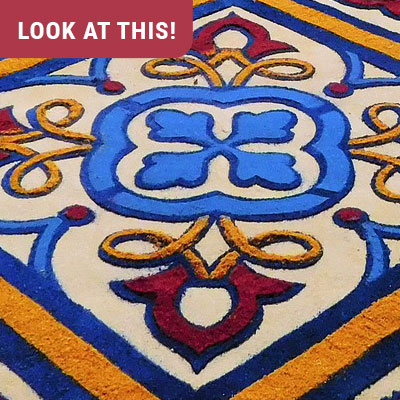
I recently heard about a beautiful custom. In many Latin American countries, carpets of sawdust are created to celebrate religious feast days. They are placed in the streets of towns ahead of processions. Some of them contain religious imagery, while others are patterned like Turkish rugs or contain images of fruit and birds. Sometimes other materials are used, such as sand and flowers. Whole towns come together to work on them.
These carpets aren’t permanent; they have to be made from scratch before the feast day every year. First, sawdust is mixed with dye to produce bright colors. Then, a first layer of plain sawdust is spread on the road to even out any bumps and provide a smooth surface. This initial layer is followed by layers of colored sawdust. Generally, large cardboard or plywood stencils are used to make complicated designs with different colors; the colored sawdust is sprinkled through the holes in the stencil. Some artists also make simple designs without stencils. The sawdust is misted with water to keep it from blowing away, and it is packed down with boards to bond it together. Of course, the road has to stay closed to traffic to keep the sawdust from being disturbed before the procession.

The town of Huamantla, in the Mexican state of Tlaxcala, is particularly famous for its carpets made in honor of the Blessed Virgin Mary. Every year on August 15th, the feast of the Assumption, the town’s statue of la Virgen de la Caridad (Our Lady of Charity) is carried in procession through the streets. To prepare for the procession, 3 and a half miles of sawdust carpets are created the night before. Making all these carpets takes so much work that the night of August 14th has come to be called “the night no one sleeps”. In León, Nicaragua, and in Antigua, Guatemala, these carpets are made for Good Friday processions. Antigua’s carpets attract thousands of tourists every year.
Most artists are very attached to their finished work. But with these carpets, it is different; they are an offering to God. The carpets are destroyed when a procession marches over them. After the procession, the remaining sawdust is swept up and cleared away. So most of them don’t even last for one full day. Recently, I watched a time-lapse video that showed a bunch of men working all day on a carpet. They carefully built it up, bit by bit, working with brooms and shovels and stencils to create a beautiful pattern. Then it was destroyed by the procession that evening. In one way, it seemed like it was a waste of time. But the men doing it seemed like they had a lot of fun working with it, and so did the people walking by in the street who stopped to talk and watch the work. Maybe you like building towers out of building blocks or legos or lincoln logs. They don’t last forever either; in fact, they are generally knocked down pretty quickly. But it is fun to build them, particularly if you’re working with somebody else! These men probably felt the same way; they spent their day praising God by creating something beautiful with their friends.

When he set for the sea its limit,
—Proverbs 8:29-31
so that the waters should not transgress his command;
When he fixed the foundations of earth,
then was I beside him as artisan;
I was his delight day by day,
playing before him all the while,
Playing over the whole of his earth,
having my delight with human beings.

